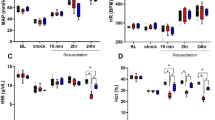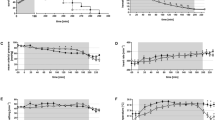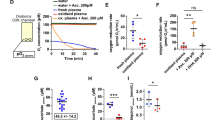Abstract
Hemoglobin-based blood substitutes are being developed as oxygen-carrying agents for the prevention of ischemic tissue damage and hypovolemic (low blood volume) shock. The ability of cell-free hemoglobin blood substitutes to affect vascular tone through the removal of nitric oxide has also prompted an evaluation of their usefulness for maintaining blood pressure in critically ill patients. Before the clinical potential of these substitutes can be fully realized, however, concerns remain as to the intrinsic toxicity of the hemoglobin molecule, particularly the interference of the heme prosthetic group with the tissue oxidant/antioxidant balance. This review provides some insights into the complex redox chemistry of hemoglobin and places an emphasis on how current knowledge may be exploited both to selectively enhance/suppress specific chemical reaction pathway(s) and to ultimately design safer hemoglobin-based therapeutics.
This is a preview of subscription content, access via your institution
Access options
Subscribe to this journal
Receive 12 print issues and online access
$209.00 per year
only $17.42 per issue
Buy this article
- Purchase on Springer Link
- Instant access to full article PDF
Prices may be subject to local taxes which are calculated during checkout



Similar content being viewed by others
References
Bunn, H.F. & Forget, B.G. Hemoglobin: molecular genetic and clinical aspects (W.B. Saunders Co, Philadelphia; 1986).
Winslow, R.M. Hemoglobin-based red cell substitutes. (Johns Hopkins University Press, Baltimore, 1992).
Chang, T.M.S. Blood substitutes: principles, methods, products, and clinical trials. Vol. 1. (ed. Chang, T.M.S.) (Karger-Lands System, New York, 1998).
Nelson, D. in Blood substitutes: principles, methods, products and clinical trials Vol. II (ed. Chang, T.M.S.) 39–57 (Karger-Landes System, New York; 1998).
D'Agnillo, F. & Alayash, A.I. Site specific modifications and toxicity of blood substitutes: the case of diaspirin cross-linked hemoglobin. Adv. Drug Deliv. Rev. (in press).
Looker, D. et al. A human recombinant haemoglobin designed for use as a blood substitute. Nature 356, 258–260 (1992).
Talarico, T., Swank, A. & Privalle, C. Autoxidation of pyridoxylated hemoglobin polyoxyethYlene conjugate. Biochim. Biophys. Acta 250, 350–358 (1998).
Song, D. et al. Comparison of the efficacy of blood and PEG-hemoglobin recovery of newborn piglets from hemorrhagic hypotension. Transfusion 35, 552–558 (1995).
Adamson, J.G. & Moore, C. in Blood substitutes: principles, methods, products and clinical trials Vol. II (ed. Chang, T.M.S.) 62–81 (Karger-Landes System, New York; 1998).
Gould, S., Sehgal, L.R., Rosen, A.L., Sehgal, A.L. & Moss, G.S. The efficacy of polymerized pyridoxylated hemoglobin solution as an O2 carrier. Ann. Surg. 211, 394–398 (1990).
Lee, R., Atsum, A., Jacobs, E.E., Austen, W.G. & Vlahakes, G.J. Ultrapure stroma free, polymerized bovine hemoglobin solutions: evaluation of renal toxicity. J. Surg. Res. 47, 407–411 (1989).
Rudolph, A.S., Klipper, R.W., Goins, B. & Philips, W.T. In vivo biodistribution of a radiolabelled blood substitute. 99mTC-labeled liposome-encapsulated hemoglobin in an anesthetized rabbit. Proc. Natl. Acad. Sci. USA 88, 10976–10980 (1991).
Sukai, H. et al. Surface modification of hemoglobin vesicles with polyethylene glycol and effects on aggregation, viscosity and blood flow during 90% exchange transfusion in anesthetized rats. Bioconjug. Chem. 8, 23–30 (1997).
Chang, T.M.S. Future prospects for artificial blood. Trends Biotechnol. 17, 61–67 (1999).
Moncada, S., Palmer, R.M.S. & Higgs, E.A. Nitric oxide: physiology, pathophysiology and pharmacology. Pharmacol. Rev. 43, 109–142 (1991).
Peah, G., Bodenham, A.R., Mallick, A., Daily, E.K. & Prezybelski, R.J. Initial evaluation of diasprin cross-linked hemoglobin (DCLHbTM) as a vasopressor in critically ill patients. Crit. Care Med. 25, 1480–1488 (1997).
Anonymous. Baxter formally pulls plug on HemAssist blood substitute, takes charges. Business News September 16 (1998).
Cashon R.E. & Alayash, A.I. Reactions of human hemoglobin A0 and two crosslinked derivatives with hydrogen peroxide: differential behavior of the ferryl intermediate. Arch. Biochem. Biophys. 316, 461–469 (1995).
Rogers, M.S., Brockner Ryan, B.A., Cashon, R.E. & Alayash, A.I. Effects of polymerization on the oxygen carrying and redox properties of diaspirin crosslinked hemoglobin. Biochim. Biophys. Acta 1248, 135–142 (1995).
Vandegriff, K.D. et al. Carbon monoxide binding to human hemoglobin cross-linked between the alpha chains. J. Biol. Chem. 266, 2697–2700 (1991).
Winslow, R.M. in Blood substitutes, new challenges. (eds Winslow, R.M., Vandegriff, K.D. & Intagliatta, M.)146–162 (Birkhauser, Boston, 1996).
Motterlini, R., Foresti, R., Vandegriff, K.D., Intagliatta,M. & Winslow, R.W. Oxidative stress response in vascular endothelial cells exposed to acellular hemoglobin solution. Am. J. Physiol. 269, H648–H655 (1995).
Marden, M.C., Griffon, N. & Poyart, C. Oxygen delivery and autoxidation of hemoglobin. Transfus. Clin. Biol. 6, 473–480 (1995).
Lee, R., Neya, K., Svizzero, T.A. & Vlahakas, G.T. Limitations of the efficacy of hemoglobin oxygen carrying solutions. J. Appl. Physiol. 78, 236–246 (1995).
Faivre, B., Menu, P., Labrude, P. & Vigneron, C. Hemoglobin autooxidation/oxidation mechanisms and methemoglobin prevention or reduction processes in the blood stream. Literature review and outline of autooxidation reaction. Artif. Cells Blood Substit. Immobil. Biotechnol. 26, 17–26 (1998).
Linberg, R., Conover, C.D., Shum, K.L & Shorr, R.G.L. Hemoglobin based oxygen carriers: how much methemoglobin is too much? Artif. Cells Blood Substit. Immobil. Biotechnol. 26, 133–148 (1998).
Phillips, W.T. et al. Polyethylene glycol-modified liposome-encapsulated hemoglobin: a long circulating red cell substitute. J. Pharmacol. Exp. Ther. 288, 665–670 (1999).
Alayash, A.I. & Cashon, R.E. Hemoglobin and free radicals: implications for the development of a safe blood substitute. Mol. Med. Today 1, 122–127 (1995).
King, N.K. & Winfield, M.E. The mechanism of metmyoglobin oxidation. J. Biol. Chem. 238, 1520–1528 (1963).
Giulivi, C. & Davies, K.J.A. A novel antioxidant role for hemoglobin. The comproportionation of ferrylhemoglobin with oxyhemoglobin. J. Biol. Chem. 265, 19453–19460 (1990).
Svistunenko, D.A., Patel, R.P., Voloshenko, S.V. & Wilson, M.T. The globin-based radical of ferryl hemoglobin is detected in normal human blood. J. Biol. Chem. 272, 7114–7121 (1997).
Svistunenko, D.A. et al. Free radical in blood: a measure of haemoglobin autoxidation in vivo. J. Chem. Soc. Perkin Trans. 2, 2539–2543 (1997).
Grisham, M.B. & Everse, J. in Peroxidases in chemistry and biology (eds Everse, J., Everse, K.E. & Grisham, M.B.) 335–344 (CRC, Boca Raton, Florida, 190091).
Buettner, G.R. The pecking order of free radicals and antioxidants: lipid peroxidation, (-tocopherol, and ascorbate. Arch. Biochem. Biophys. 300, 535–543 (1993).
Goldman, D.W., Breyer, R.J., Yeh, D., Brockner Ryan, B.A. & Alayash, A.I. Acellular hemoglobin-mediated oxidative stress toward endothelium: a role for ferryl iron. Am. J. Physiol. 44, H1046–H1053 (1998).
McLeod, L. & Alayash, A.I. Detection of a ferryl intermediate in an endothelial cell model after hypoxia/reoxygenation. Am. J. Physiol. (in press).
Moore, K.P. et al. A causative role for redox cycling of myoglobin and its inhibition by alkalization in pathogenesis and treatment of rhabdomyolosis-induced renal failure. J. Biol. Chem. 273, 31731–31737 (1998).
Gulati, A., Barve, A. & Sen, A.P. Pharmacology of hemoglobin therapeutics. J. Lab. Clin. Med. 133, 112–119 (1999).
Winslow, R.M. et al. Vascular resistance and efficacy of red cell substitutes in rat hemorrhage model. J. Appl. Physiol. 85, 993–1003 (1998).
Hess, J.R., Macdonald, V.W. & Brinkley, W.W. Systemic and pulmonary hypertension after resuscitation with cell-free hemoglobin. J. Appl. Physiol. 74, 1769–1778 (1993).
Weil, M.H. & Afifi, A.A. Experimental and clinical studies on lactate and pyruvate as indicators of the severity of acute circulatory failure (shock). Circulation 41, 989–1001 (1970).
Abassi, Z. et al. Effects of polymerization on the hypertensive action of diaspirin cross-linked hemoglobin in rats. J. Lab. Clin. Med. 129, 603–610 (1997).
Rolfs, J.R. et al. Arterial blood pressure responses to cell-free hemoglobin solutions and reaction with nitric oxide. J. Biol. Chem. 273, 12123–12134 (1998).
Caron, A. et al. Cardiovacular and hemorheological effects of dextran-conjugated hemoglobin, (a)-crosslinked hemoglobin, and o-raffinose polymerized hemoglobin in hemodiluted rabbits. J. Appl. Physiol. 86,541–548 (1999).
Doyle, M., Apostol, I. & Kerwin, B.A. Glutaraldehyde modification of recombinant human hemoglobin alters its hemodynamic properties. J. Biol. Chem. 274, 2583–2591 (1999).
Wink, D.A. & Mitchell, J.B. Chemical biology of nitic oxide:insights into regulatory, cytotoxic and cytoprotective mechanisms of nitric oxide. Free Radic. Biol. Med. 25, 434–456 (1998).
Alayash, A.I., Brockner Ryan, B.A. & Cashon, R.E. Peroxynitrite-mediated heme oxidation and protein modifications of native and chemically modified hemoglobins. Arch. Biochem. Biophys. 349, 65–73 (1998).
Lascalzo, J. Nitric oxide binding and adverse effects of cell-free hemoglobins: what makes us different from earthworms. J. Lab. Clin. Med. 129, 580–583 (1997).
Liu, X. et al. Diffusion-limited reaction of free NO with erythrocytes. J. Biol. Chem. 273, 18709–18713 (1998).
Doherty, D.H. et al. Rate of reaction with nitric oxide determines the hypertensive effect of cell-free hemoglobin. Nat. Biotechnol. 16, 672–676 (1998).
D'Agnillo, F. & Chang, T.M.S. Polyhemoglobin-superoxide dismutase-catalase as a blood substitute with antioxidant preoperties. Nat. Biotechnol. 16, 667–672 (1998).
Alayash, A.I., Brockner Ryan, B.A., Eich, R.E., Olson, J.S. & Cashon, R.E. Reactions of sperm whale myoglobin with hydrogen peroxide: effects of distal pocket mutations on the formation and stability of the ferryl intermediate. J. Biol. Chem. 274, 2029–2037 (1999).
Darley-Usmar, V.W. & Radomski, R. Free radicals in the vasculature—the good, the bad, and the ugly. Biochemist (Bulletin of the Biochemical Society) 13–17 (1994).
Acknowledgements
I thank B. Brockner Ryan, V. Macdonald, D. Goldman, and F. D'Agnillo for reading the manuscript and for their helpful suggestions.
Author information
Authors and Affiliations
Rights and permissions
About this article
Cite this article
Alayash, A. Hemoglobin-based blood substitutes: oxygen carriers, pressor agents, or oxidants?. Nat Biotechnol 17, 545–549 (1999). https://doi.org/10.1038/9849
Received:
Accepted:
Issue Date:
DOI: https://doi.org/10.1038/9849
This article is cited by
-
βCysteine 93 in human hemoglobin: a gateway to oxidative stability in health and disease
Laboratory Investigation (2021)
-
Qualitative Determination of Hemoglobin in Rats with Septic Shock by Photoacoustic Spectroscopy
International Journal of Thermophysics (2019)
-
Polynitroxylated-Pegylated Hemoglobin Attenuates Fluid Requirements and Brain Edema in Combined Traumatic Brain Injury Plus Hemorrhagic Shock in Mice
Journal of Cerebral Blood Flow & Metabolism (2013)



